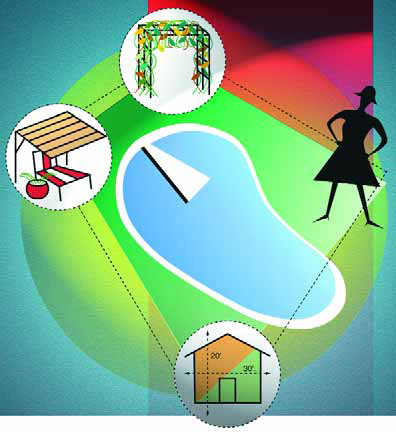safety
Composition of this article began with an e-mail I received a while ago from a colleague working in Australia. "What," he asked, "is the maximum allowable depth for a fountain in the United States?" As simple as it sounded, when I took the time to research the issue I found that there was a noticeable lack of definition. I took the next logical step and called various people I know in the watershaping industry and asked them the same question. Surprisingly enough, nobody could point me to any code, regulation or standard that defined what depth a waterfeature's pool could
Founded in 1634, Boston Common is the oldest public park in America - a significant and historic public place. It is familiar to us as Bostonians, of course, but we've also been privileged as a firm to have worked there before, when we renovated the park's main watershape, the Frog Pond, to serve as a splash pool in summer and as an ice-skating rink in winter. During the pond renovation, we learned that tackling projects in such storied surroundings can be a tall order. For example, we had to place all of the pond's chillers and pumping equipment underground to mask any obvious intrusion on the 17th-century space. As we approached a second major project - this time the renovation of the park's playground - we knew going in that those who hired us were keenly sensitive to the nature of the place and came armed with preconceptions about colors, images and what would be "appropriate" for the setting. To keep things moving, we worked very closely with the city's Historic Commission in establishing the color palette, procuring artwork and developing an overall plan that would result in a space that was attractive and safe for children and suited to the surroundings. To be sure, the negotiations were intense as we
When clients call me in to design their backyards, one of the main things many of them want is a safe environment for their children. I've always thought of myself as a big kid at heart and also look at things as a father, so I've always felt confident and fully prepared meet my clients' desires while creating spaces that really work for kids. How little we sometimes know! After reading A Child's Garden: Enchanting Outdoor Spaces for Children and Parents by Molly Dannenmnaier (Simon & Schuster, 1998), it's now clear to me just how much more can be done in watershape and garden spaces to engage children of all ages. Indeed, this book showed me that there's much, much more to designing for children than
Just as with species in the animal kingdom, architectural construction styles and techniques evolve over time, adapting to changes in the environment. In the case of fountains, these evolutionary transitions have been both complex and indicative of broader trends. Ancient wellsprings, for example, eventually gave way to decorative fountains with intricately carved stone sculptures. More recently, monolithic block, walled and stepped fountain forms have held sway. It's not much of a stretch to say that the latest significant "mutation" in this remarkable lineage is the dry-deck fountain: At a time when open space is at a premium and the public is being invited as never before to interact and participate in the architectural landscape, dry-deck fountains may well be the
The notion that water can be used to treat physical problems and conditions is not new. In fact, when you study the history of watershaping and aquatic design, one of the first things you learn is that the ancient Romans might actually have had a better grip on the healing and nurturing powers of water than we ever will. In our own work in designing and installing environments that nurture the spirit and invigorate the body, we pursue that Roman heritage as best we can - and always keep water in mind as a key component. The project described in this article stands as one our most dramatic explorations of the curative power of water to date. The pool, spa and
It was a rainy Wednesday morning in January when I first toured the Clearwater Marine Aquarium. I was on hand to inspect the recent installation of a pair of our horizontal sand filters for the facility's marine-mammal pool and see just how well the pool-filtration products were faring in this somewhat unusual (but not unheard of) application. Located on Island Estates in Clearwater, Fla., the aquarium was bustling with activity from the moment the doors opened at 9 a.m. On this day, a group of pre-school children had arrived to see the aquarium's newest dolphin, Presley, and his friend, Panama. The staff also explained to me that the aquarium, like other indoor attractions, is always busier when the rain falls. I joined right in with the crowd, fascinated by everything I was seeing. My guide, the aquarium's director of life support and marine facilities, Bill Meier, led me to the marine mammal pool - currently home to Presley and Panama but with the capacity to hold several more. This was the vessel on which my company, Pentair Pool Products of Sanford, N.C., had installed the sand filters. As I watched the children's faces as they in turn watched the dolphins, I began to realize that we were
Interactive watershapes are all about invitations to play. For designers, interactive watershapes provide invitations to use water and the control of flowing water to create unique play environments. For children, teenagers, parents and other adults, they are invitations to play with one another in a safe and exciting aquatic playground. It's a form of invitation that's rapidly gaining popularity in an era when playtime for both children and adults has become excessively passive and dominated by surfing the net, playing computer games or staying glued to
Contrary to the impression that might be given by the headline, this isn't an article about building arbors that are safe. Rather, it's about how you can protect your clients and their guests from the sun by building beautiful structures in their yards. (Safety is part of the discussion, too, but not its focus.) I bring this up because many clients put piles of money into building spectacular pools but fail to give much thought to their surroundings. That's a shame, because those surroundings almost certainly will be seen much more than the pools will be used in the course of the average year. Several things need to be






















